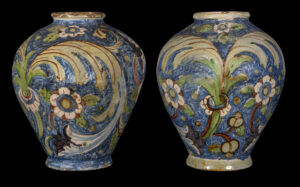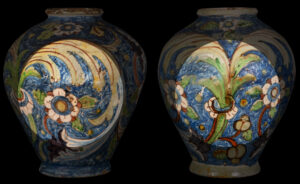Majolica Vases
Glazed terracotta
Italian, 16th or 17th century
Earthenware that has been coated with a white glaze and then decorated with other pigmented glazes was first made in Africa around the 6th century. By the 13th century multi-colored designs were possible. A final clear glaze added luster and insured the pieces were watertight. Large quantities of decorative earthenware were produced in Africa and Spain and passed through ports on the island of Majorca on their way to Italy. Thinking the colorfully painted pieces had originated in Majorca, Italians called them majolica.
By the 16th century, techniques for producing majolica had reached Italy. As would be expected, Italian ceramicists stretched the artistic limits of the medium. Although many early majolica pieces were purely functional and received little decoration, others were elaborately decorated and served as status symbols. In wealthy homes large collections of vibrant dishes, bowls, platters, pitchers, jars, and vases were displayed and used to impress guests.
However, many Renaissance majolica containers were used for storage. In the kitchen, these useful jars stored liquids, grains, nuts, dried fruits and the like. What an apothecary of the period might keep in one can only be imagined. Generally larger majolica containers did not have lids. They usually have a short neck, and the opening has an everted edge, allowing the jar to be covered with cloth, paper, or leather and tied in place over the mouth with a string or strap around the jar’s neck.
Smaller Renaissance majolica containers were rectangular boxes or cylinders with concave sides. The lack of handles permitted them to be stored close together on a shelf, and their shape allowed handling without slipping. Larger vessels were generally spherical or, like M&G’s, ovoid with the smaller end toward the bottom. Today these larger containers are often called majolica vases, though their original purpose wasn’t decorative.
Smaller majolica vases could be picked up by putting hands under the wide part of the vase. M&G’s 15½-inch tall and 13-inch diameter vases are considered large. Each vase weighs nearly 12 lbs. and holds about 4.5 gallons of liquid. A full vase would weigh nearly 50 lbs., which would require considerable strength and balance to lift and carry.
M&G’s Majolica Vases have a 5-inch diameter opening. Although the rounded lips would aid in pouring, the mouth is wide enough for a hand or a ladle to access the contents.
The decoration on M&G’s vases includes white, daisy-like flowers with a blue ring around the darker center. These flowers with scrolling foliage (sometimes protruding through the flower) and swirling, plume-like shapes are common on Italian Renaissance containers. The blue background would have been painted after the design of the floral decoration. The short, irregular white curves were inscribed into the blue areas before it was fired. Because of the stability of the pigments and the clear glaze, the colors are still vibrant.
Prior to the 1800s few European ceramics have an identifying mark or a signature, and it is extremely rare for any Italian Renaissance piece to be signed or dated. Documented provenance would help determine age and origin or perhaps a design with a family crest or istoriato (having a portrait or a historical or biblical image). However, typical of most such pieces, M&G’s vases lack marks and embellishments, and their provenance extends to just under 100 years.
The opinions of museum curators and experts which specialize in the genre are the primary remaining source for information. M&G’s vases have been examined by experts, who believe the vases were made in Sicily during the late 16th or early 17th century.
Renaissance majolica is strong, but it can easily be broken. For a pair of large vases to have endured 400 years is remarkable, especially surviving their practical role and years spent in cellars and storerooms. Today museums proudly display glued-together objects of Italian Renaissance majolica, even if they are missing sections of the piece. M&G’s large and unbroken Majolica Vases are a treasure indeed.
William Pinkston, retired educator and M&G volunteer
Special thanks to students from the Honors Geometry classes of Bob Jones Academy for determining the vase volume and weight.
Published 2023

